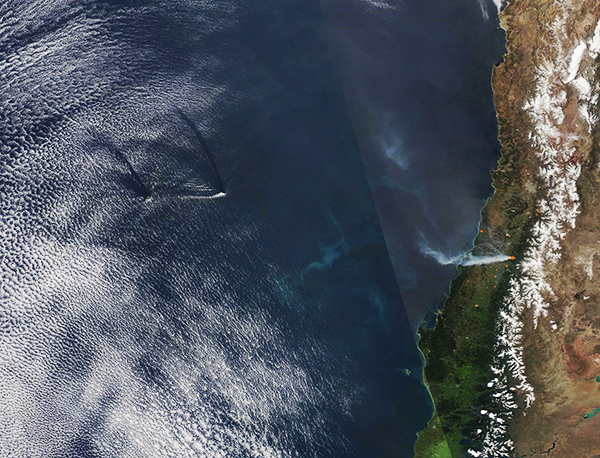Images
November 2, 2022 - Fires, Cloud Wakes, and Blooms Mark Springtime in Chile
Tweet
Wildfires, cloud wakes, and a widespread phytoplankton bloom created a complicated mosaic of natural phenomena in and around central Chile in the closing days of October 2022. The Moderate Resolution Imaging Spectroradiometer (MODIS) on board NASA’s Aqua satellite acquired a true-color image capturing all three features on October 31.
Multiple red “hot spots” speckle Chile’s Central Valley, which sits west of the snow-capped peaks of the Andes Mountains. Each hot spot marks an area where the thermal bands on the MODIS instrument detected high temperatures. When accompanied by typical smoke, as in this image, such hot spots are diagnostic for active fires. The largest fire, the Lomillas Altas, was burning on 54.1 hectares in the Maule Region and was pumping heavy smoke into the atmosphere. Strong winds carried the gray plume past the coast and over the Pacific Ocean.
Northwest of the fires and far out over the ocean, two long cloud-free streaks cut across a bank of thin cloud. Each of these “cloud wakes” appear on the lee side of two volcanic islands. Isla Alejandro Selkirk and Isla Robinson Crusoe are both volcanic islands arising from an east-west submarine ridge. Poking up from the ocean surface, the islands create obstacles to air movement, such that wind blowing over each island creates a giant wedge shape of cloud-free air, with the island at the base.
Sandwiched between cloud wakes and smoke plumes, jewel-toned swirls color the Pacific Ocean. The color is created by large masses of floating phytoplankton, which are microscopic plant-like organisms that live in these waters in small numbers year-round. When conditions are just right (adequate light, warm water temperatures, and plentiful nutrition), phytoplankton can reproduce explosively to create massive blooms that are easily viewed from space.
Image Facts
Satellite:
Aqua
Date Acquired: 10/31/2022
Resolutions:
1km (482.2 KB), 500m (1.6 MB), 250m (4.7 MB)
Bands Used: 1,4,3
Image Credit:
MODIS Land Rapid Response Team, NASA GSFC
Tweet
Wildfires, cloud wakes, and a widespread phytoplankton bloom created a complicated mosaic of natural phenomena in and around central Chile in the closing days of October 2022. The Moderate Resolution Imaging Spectroradiometer (MODIS) on board NASA’s Aqua satellite acquired a true-color image capturing all three features on October 31.
Multiple red “hot spots” speckle Chile’s Central Valley, which sits west of the snow-capped peaks of the Andes Mountains. Each hot spot marks an area where the thermal bands on the MODIS instrument detected high temperatures. When accompanied by typical smoke, as in this image, such hot spots are diagnostic for active fires. The largest fire, the Lomillas Altas, was burning on 54.1 hectares in the Maule Region and was pumping heavy smoke into the atmosphere. Strong winds carried the gray plume past the coast and over the Pacific Ocean.
Northwest of the fires and far out over the ocean, two long cloud-free streaks cut across a bank of thin cloud. Each of these “cloud wakes” appear on the lee side of two volcanic islands. Isla Alejandro Selkirk and Isla Robinson Crusoe are both volcanic islands arising from an east-west submarine ridge. Poking up from the ocean surface, the islands create obstacles to air movement, such that wind blowing over each island creates a giant wedge shape of cloud-free air, with the island at the base.
Sandwiched between cloud wakes and smoke plumes, jewel-toned swirls color the Pacific Ocean. The color is created by large masses of floating phytoplankton, which are microscopic plant-like organisms that live in these waters in small numbers year-round. When conditions are just right (adequate light, warm water temperatures, and plentiful nutrition), phytoplankton can reproduce explosively to create massive blooms that are easily viewed from space.
Image Facts
Satellite:
Aqua
Date Acquired: 10/31/2022
Resolutions:
1km (482.2 KB), 500m (1.6 MB), 250m (4.7 MB)
Bands Used: 1,4,3
Image Credit:
MODIS Land Rapid Response Team, NASA GSFC




